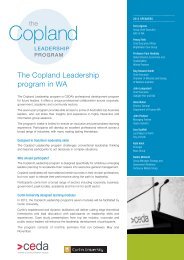A Greater Australia: Population, policies and governance - CEDA
A Greater Australia: Population, policies and governance - CEDA
A Greater Australia: Population, policies and governance - CEDA
- No tags were found...
Create successful ePaper yourself
Turn your PDF publications into a flip-book with our unique Google optimized e-Paper software.
Section 4.3were either the full economic value of that water (what it is worth) or the true economiccosts of collection, storage <strong>and</strong> distribution, then the value of water entitlements in thesecondary markets might have been closer to $20 per ML than $1200 or $2000/ML. 23Furthermore, irrigators facing the real price of supplying water would presumably havedem<strong>and</strong>ed less than they do at the heavily subsidised price, reducing the quantum ofentitlements required for environmental purposes.Few, if any, existing irrigation schemes generate sufficient revenue at current watercharges to cover their existing capital costs, let alone the operating costs or the opportunitycosts of the water itself. 24 The $6 billion infrastructure “investment” initiative in theWater for the Future program largely represents a gift to irrigators.Whatever the conditions of cost recovery, it remains the case that water purchases fromirrigators provide the most efficient method of securing additional environmental flows.There are numerous claims about the severity of the regional damage to be wreaked bythe $3 billion buy-back of water entitlements. However, economic modelling stronglysuggests considerably less detrimental effects than often claimed. 25The key to achieving a sustainable allocation of water in the MDB is to ensure that theprice of water achieves full cost recovery.Urban water securityMelbourne has historically relied on water supply from reservoirs that, for 90 years, hadrelatively reliable inflows. This reliability meant that, until recently, Melbourne’s watersupply system was projected to be adequate until the 2030s, even with a moderategrowth in the population. However, by 2007, expectations changed with evidencethat the most severe drought in history was in progress. Scientific advice was thatthe future would bring steep declines, of up to almost 40 per cent, of water inflowsinto Melbourne’s catchment areas. 26 A similar pattern was predicted for all EasternSeaboard capital cities.It is clear that Melbourne’s historical water supply systems, <strong>and</strong> those of other capitalcities, did not have the resilience to cope with the dual shocks of greater populationgrowth <strong>and</strong>, especially, the unprecedented, prolonged drought. The planning institutionsfor urban <strong>and</strong> rural water supply buckled under the stress. The National WaterCommission stated:“The government intervened in water planning <strong>and</strong> investment decisions, first byrestricting dem<strong>and</strong> then by directing large-scale investments to boost supplies.This blurred the lines of accountability <strong>and</strong> created uncertainty about the roles <strong>and</strong>responsibilities of those involved in water delivery <strong>and</strong> regulation.” 27On the dem<strong>and</strong> side a number of initiatives were launched to encourage water conservation,severe restrictions were introduced <strong>and</strong> household water use dropped. Withoutthese initiatives, Melbourne would have run out of water in 2009 (see Figure 3). Itappears as though community’s use of water has experienced a sustained downwardshift, with lower levels of use continuing in Brisbane <strong>and</strong> Melbourne. The experience ofthe drought revealed the potential to significantly alter community use of water.Major investments in augmentation were also undertaken, with approximately $30billion in new infrastructure deployed. 28 These infrastructure investments have essentiallyinsured <strong>Australia</strong>’s major urban centres have sufficient desalination capacity tosupply almost 50 per cent of capital city water needs, based on 2008/09 water consumption,29 effectively removing the threat of drought to these major urban centres.A <strong>Greater</strong> <strong>Australia</strong>: <strong>Population</strong>, Policies <strong>and</strong> Governance208





